
Fallen
Overview
Your world is threatened by a terrifying entity you suspect is currently amassing power in the abandoned mines at the end of town. You grab what meager equipment you can find and decide to take matters into your own hands. You jump heedlessly into the mines completely unaware of the challenges that face you… but you know you’re going to find this demon and give it your best shot. Welcome to Fallen…
![]()
![]()
Set Up
It’s easy to fall into the trap of assuming games made up nearly entirely of cards are simple to set up. The more complicated the card game, the more likely you are to have to construct decks before the game… and with Fallen you have several to construct.
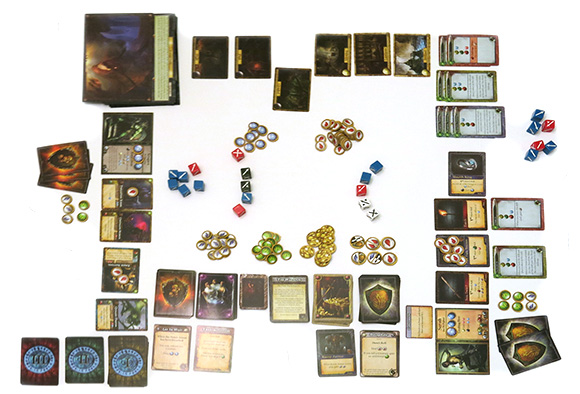
Cards are the bulk of the components, and you’ll be spreading decks out all over your table before you play. But before any of the set-up can be done, you need to pick your characters.
There are three Heroes and three Dungeon Lords included in Fallen – one player must choose between the Heroes, while the other picks a Dungeon Lord. Place the Character Card of the character you’ve chosen directly in front of you. The Hero will have three pieces of starting equipment listed on the back of its card – you will find these on the four double-sided “Basic Equipment Cards”, and place the appropriate side face-up next to the Hero Character Card. Now you can start constructing decks!
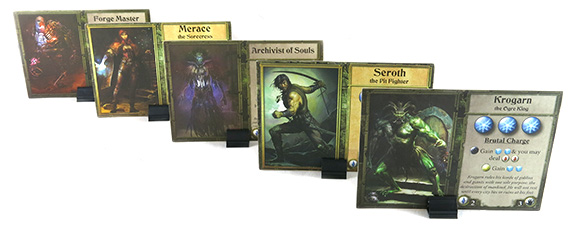
The biggest decks in Fallen belong to the Power Cards. Both players must construct 20-card decks of Power Cards for their character, with these cards coming out of a pool of 50 possible cards (apiece) based on the characters chosen. Their are 20 generic Power Cards in each deck as well as 10 cards tailored specifically to each of the three Heroes/Dungeon Lords. You will claim the 10 cards with your Hero/Dungeon Lord’s face on them, then randomly select 10 of the generic Power Cards to form your deck. Place these decks within arms-reach, but not too close to your Character Card.
The next deck that needs some pre-game management is the Final Battle deck. There are 42 Final Battle cards included in Fallen – 14 for each of the Dungeon Lords. You need to extract the 14 cards belonging to the chosen Dungeon Lord and place them face-down near the Hero player. One of these cards will look different – it’s got text on both sides rather than the wall of fire illustration contained on the backs of the others. This card should be placed on top of the deck with its “Final Battle Begins” side up.
The “Hero” player needs to claim the 9 Skill Cards associated with their chosen Hero and keep them nearby, picking one to start the game with. The rest of the decks are used in their entirety with no need for additional attention. You’ll place close to the Hero player the deck of Treasure Cards, and near the Dungeon Lord player the decks of Creature Cards (separated into three “levels”), Story Cards and Critical Cards.

The Shadow Track – used to denote the current mood of the Dungeon (light if favoring the Hero, dark if favoring the Dungeon Lord) is arranged to the side between the players. This is made up of six cards, and must be arranged with the “light” cards closest to the Hero player and the “dark” cards closest to the Dungeon Lord.
(we’re almost there…)
There are several piles of tokens that need to be set in reach of both players – Wound Tokens, Experience Tokens, Fortune Tokens, Reward Tokens and Charge Tokens. Each player claims three Charge Tokens and places them on the designated spot of their Character Card. Lastly, each player claims their dice – six blue and three red apiece, with two white dice going to the Hero and two black dice going to the Dungeon Lord.
Gameplay
For all of the rigorous set-up, things get much smoother when the game starts.
The Dungeon Lord kicks things off by reading the story foundation on the back of their Character Card and offering the Hero player the first of many choices. Does the Hero wish to venture into a dank-smelling cave? Or perhaps explore the whereabouts of a far-off scream?
This initial decision is the only one in the game that does not result in an encounter – instead it serves to set the opening temperature of the Shadow Track and give the Dungeon Lord or Hero an extra resource or two before things get exciting.
The Dungeon Lord next draws the top Story Card and reads its opening to the Hero. The Hero is again offered a choice… but henceforth all choices are met with an encounter. There are three basic types of encounters in Fallen: Agility, Knowledge and Strength. Each of these encounters can be Easy, Normal or Hard, giving 9 total possibilities. The Hero’s Character Card will specify which dice they get to roll for each encounter type. The Dungeon Lord always rolls two black dice in addition to dice granted by the monster they choose to attack the Hero with.

Each Story Card contains four choices with up to 11 variable encounters. The Hero will navigate these choices with two important factors in mind: which encounter do I think I’m more likely to win, and which path of encounters is most likely to lead to the best Story Card resolution for me? As you might guess, these are usually mutually exclusive.
Three story cards are played through in this manner (engaging in a total of 12 encounters) before moving on to the Final Battle. Once the Final Battle begins the Hero player takes over the story-telling responsibilities, drawing cards from the Final Battle deck and reading them aloud before announcing the encounter type on the card. The winner of a Final Battle encounter earns that Final Battle card – and the first to hold three Final Battle cards wins the game! But we’ve skipped over some of the most interesting nuts-and-bolts to Fallen, so let’s back up a little.
Heroes and Dungeon Lords level up through collecting and spending Experience Tokens. Both players will earn these through winning encounters; the Hero player also earns these through killing monsters and navigating the best path through Story Cards (all paths will earn at least 1 Experience Token for the player, but harder paths will earn more), while Dungeon Lord players earn these through breaching the Hero’s armor. The Dungeon Lord also receives a pre-determined number of Experience Tokens at the end of each Story Card – one at the end of the first, two at the end of the second, and three at the end of the third.
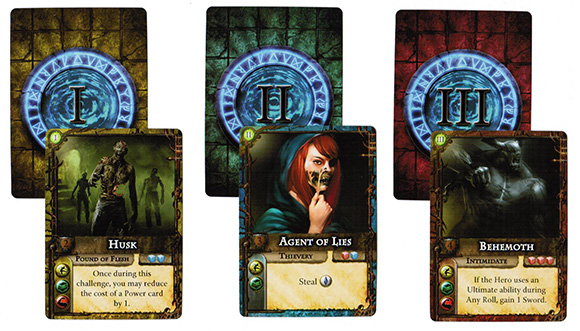
The Dungeon Lord player levels up their monsters. At all times the Dungeon Lord has four monsters at their disposal to exhaust during encounters. This player will begin the game with four level 1 monsters. By paying 2 Experience Tokens one level 1 monster can be upgraded to level 2. That level 2 monster can be further upgraded to level 3 by paying 3 Experience Tokens. These monsters are randomly drawn from three Monster Decks numbered 1, 2 and 3. When a monster is slayed by the Hero, that monster goes to the bottom of the deck it came from and a new monster is drawn from the top of that deck. All Dungeon Lords use the same monsters.
Leveling up the Hero is more interesting. With Experience Tokens the Hero can upgrade their Skills – three different sets of three cards sitting to the side of the play area that enhance the dice rolled by the Hero for some or all of the encounter types. Unlike the Dungeon Lord, who upgrades through blind draw (having no say in what they’re upgrading to, only which monster they’ve chosen to upgrade), the Hero chooses which Skills they build and which they ignore. Heroes can also upgrade their Basic Equipment Cards – without spending Experience Tokens – via the Treasure Deck. Heroes start with three pieces of equipment – one Weapon, one Armor and one Item. All of these can be upgraded through rewards granted from Encounters (win or lose). The Hero can hold an additional Item, but they’re limited to one Weapon and one Armor.
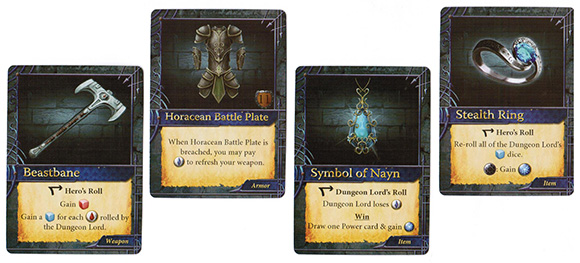
While the Hero is working to enhance themselves, the Dungeon Lord is working to weaken them. Wounds are inflicted (by both Hero and Dungeon Lord) when a wound symbol is rolled during an encounter (the winner of the encounter is determined by who rolled the most swords – the primary symbol on the die – but there are two other small symbols that may appear to either side of the sword; the wound symbol is one of these, and is the only way to inflict actual damage). When the Hero rolls a wound symbol they may place one Wound Token on the active monster (these take 2, 3 or 4 wounds to kill depending on level). When the Dungeon Lord rolls a wound symbol they place one Wound Token on the Hero’s armor. Armors take between 7 and 10 wounds to breach, but when they breach it’s bad for the Hero. The armor doesn’t go away (the wounds are simply cleared away and damage begins stacking up again), but every breach allows the Dungeon Lord to draw from the Critical Deck.
Critical Cards either weaken the Hero (for instance, forcing them to have more of a resource than normally required to pull off an action) or strengthen the Dungeon Lord (possibly adding additional dice to a monster’s pool or increasing the number of wounds necessary to kill them). While the Hero is upgrading their Skills to earn more dice, the Dungeon Lord will be breaching armor to take them away.
There are several ways for both Dungeon Lord and Hero to alter or add to their dice rolls. Each player starts with two Power Cards (with more earned through Encounters), which are played at a defined time (such as “Hero’s Roll” or “Dungeon Lord’s Roll”) and help sway an encounter in your favor. These usually require Fortune Tokens to play, with differing costs depending on whether the Shadow Track is currently light or dark (the Hero will pay a lower cost in the light, the Dungeon Lord a lower cost in the dark). Each player begins each Story Card (and the Final Battle) with five Fortune Tokens, and more can be earned through Encounters. Fortune Tokens can also be cashed in during an encounter to add up to two blue dice (the weakest of the dice) to a roll. This can be done after your initial roll, allowing you to only use them for this purpose when necessary. Finally, most of the Hero’s Equipment Cards can be exhausted to add dice to Encounters – although it’s usually pretty restrictive (something like “add 1 blue die to Agility encounters”).
Components
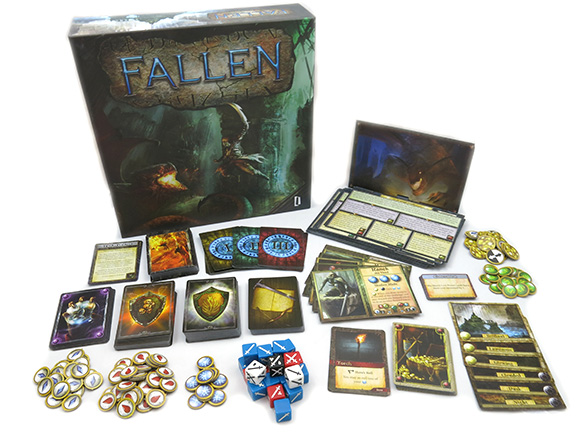
Fallen is top notch through-and-through. All cards are stable and don’t require sleeving (nothing needs shuffling after set-up)… and the illustrations are gorgeous. It’s worth mentioning that most cards don’t contain artwork – they’re very word-heavy. Only Character Cards, Monster Cards and Treasure Cards are illustrated.
The custom dice are terrific. They’re big (18mm), flawlessly printed and easy to understand. Finally, there’s a bunch of quality cardboard bits.
Learning Curve
Initially learning the rules takes some time. The rulebook is well-organized and thorough, but there is a decent amount there. To understand everything that will be thrown at you will take a good hour (at least). However, it’s all so sensible that you won’t need to run back to the rulebook much during your games (maybe once or twice your first game, then never again).
And it’s actually a lot easier to teach than it is to learn – primarily because the rulebook contains a page near the end titled “How to Teach New Players”, which walks established players through important items worth explaining to a new player prior to the game and which should be left for explanation once they come up in the game (because they wouldn’t affect the new player’s decision-making). It’s a very sharp and useful feature.
Getting good at the game will take a little longer from the Hero side than the Dungeon Lord side. While the Dungeon Lord has interesting decisions to make – such as when to use which monsters and resources – the Hero player has to master those choices (with equipment instead of monsters) in addition to trying to navigate the decisions on the Story Cards. More often than not the decisions you’ll make on the Story Cards lead down the road you would expect (the path that seems like it will lead to fighting a monster ends up with a Strength test; the path that seems like you’ll run from the monster leads to an Agility test). Getting good at navigating your path takes some practice.
Who would enjoy this game?
Final Thoughts
What we have here, friends, is a game so outstanding that we’ll be playing and talking about it for years. Fallen is beautifully engaging right out of the box, and it’s absolutely bursting with possible expansions (which I’m sure Watchtower Games has at the forefront of their minds).
The included Heroes and Dungeon Lords are sufficient for dozens and dozens of plays, but there’s a lot of room for additional characters (particularly Dungeon Lords). And it’s impressive how many Story Cards you get with the base game… but Watchtower could keep this thing going indefinitely just by releasing 15 new Story Cards every year.
Fallen is a game that keeps you enthralled in its theme with words rather than pictures or components. You can feel your character making a decision to attack a rampaging orc (or deciding to hide behind a tree and hope it doesn’t see you). Every piece of armor or fancy new item that you find will feel like the accomplishment that will bring down that bad Dungeon Lord (or… each monster upgrade and Critical Card will feel like the one that will stop that pesky Hero once and for all).
User Reviews (2)
Add a Review for "Fallen"
You must be logged in to add a review.

I also learned to play this online on Tabletop Simulator. After one game, I ordered it to have. It is a top game on my shelf. There are a lot of rules at first, but everything happens one step at a time, so it is easy to learn. The components are good, I like my cards a little thicker, but they are good. The key to the game and why it is so great is the amount of choices both players have. As the hero, you have choices right from the start. Do you want your character to specialize in certain skills, or be more of a generalist? Then, just to set up, you have to make a choice. And then, the best part of it, is that no matter what choice you make, the game will still balance out the players, so that by the final battle, the game is still very close. I have played a game as the dungeon lord and have one every battle and had a great advantage going into the final battle, but then ended up losing due to a couple of unlucky die rolls. That doesn’t happen often, but enough to make the game worth paying to the bitter end.
The game mechanic is very unique, and it is wide open for expanding the story cards, more enemies and more heroes. Truly an awesome, fun game.
I purchased this game after watching a play-through online. I was drawn in by the fantasy theme, the “choose your own adventure” story-telling, and the dice battling mechanics. The overall gameplay is great. It seems like it might be a complicated game to learn, however after a round or two you feel like a seasoned pro. You either choose an adventurer or a villain and choose scenarios to shape a story. Each choice can affect what outcome takes place as well as what attributes are strongest for that story. Dice are added dependent on which modifiers are prevalent to the section of adventure. Players can then use special cards and abilities to strengthen their dice rolls. Essentially whomever has the larger dice roll wins the round. During the adventure players can level up skills or minions and obtain treasures or traps. The components of the game are very nice as well. The cards have fantastic art, the dice are great, and the box does a nice job of storing all the pieces together. I would highly recommend this game to anyone who loves a good fantasy themed dice game. I also learned that 2 expansions are going to be released which makes for an even deeper experience and greater replayability.